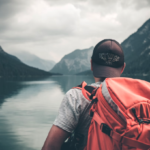Within the confinements of Harbor Boulevard, Katella Avenue, Ball Road and Walnut Street in Anaheim, CA resides the 510-acre Disneyland Resort. The amusement park draws more than 16 million guests annually, creating a substantial increase in business for the local hotels.
There are many hotels within close proximity to the park, a few of which are the biggest in the state. Though it pales in physical size to many of its competitors, one of the most visible options is Ramada Maingate at the Park.
Ramada Maingate at the Park has been able to put itself on the map, both in terms of its accessibility to/from Disneyland and amongst the Ramada brand, via social media.
Andrew Ho was hired March 2010 to manage social media for the hotel. Prior to his arrival, miscellaneous staff members would tend to Twitter and Facebook when they could, but because of everyone’s already busy schedules, the pages weren’t consistently updated nor did they have a truly effective presence.
A lot has changed since then. Their Twitter page has 1,000 followers while their Facebook page has 3,000 fans, and there’s a great variety of interaction taking place on a regular basis. The unique way Andrew communicates makes the pages stand out amongst other hotels. He didn’t create a persona; he simply uses his own. This has been hugely valuable in humanizing the brand and thereby creating personal connections with potential customers.
Being so close to Disneyland, it makes sense to convey a fun and exciting identity, which causes people to develop fun association with the hotel itself. Ramada’s tweets include questions like, “Who wants to come play hide and seek in Disneyland?” among other more broad comments like, “While teaching his son how to vacuum, my boss ended up vacuuming my office #lifeisgood.” Silly as they may sound, such tweets easily put a smile on people’s faces and subsequently create a positive association.
“I’ve gotten people to like the brand without their having experienced it. People come in saying they’re excited to stay with us because we seem fun,” Andrew says.
The hotel is ahead of the general Ramada curve in that Andrew’s boss is one of the first Ramada owners that was willing to spend money on a person dedicated to social media. At a Ramada regional meeting, people in high positions approached Andrew for feedback. He explained that “social media is where technology meets customer service, and people who are good at customer service can be good at social media.”
He recalled a specific encounter with social media as a customer service tool – when a recent guest vented on Twitter about being mistreated at the hotel, he was able to apologize and explain the circumstances, leaving the guest completely satisfied at the end of the exchange. Had he not been on Twitter, the guest would have probably had a negative perception of the hotel engrained in her mind, and that’s what she would have shared with her peers about her experience. Instead, she’ll mention the mishap but then draw attention to how the staff listened, addressed the matter and resolved it.
Maingate recently broadened its online scope by adding video to the mix. Andrew approached his boss and inquired, “What would it look like if we could show everything through video?” On a Friday, via iPhone, they shot a video recording the walk to Disneyland (approximately 3 minutes). By Monday, it was online. They also just did a video documenting finding parking in the Disneyland parking structure, and a few weeks ago, one on a guest checking in to the hotel. The videos have received exclusively positive feedback and substantially increased traffic to the hotel’s website.
They also hired Notixtech, a mobile marketing company, to create a mobile website. This allows guests to have simple, clean access to any information they may need about the hotel directly through their smartphones. The mobile site gets around 30 hits per day, which means over 200 guests per week are having their travel experience simplified.
At one point, Andrew had to justify to higher-ups the need for a full-time social media person and, basically, fight for his job. He did so by explaining that the conversation is out there happening regardless of whether they’re a part of it. “We must be proactive rather than reactive,” he noted, “we have the option to ignore it, listen to it, or engage in it.”
Not only is Andrew still employed, he now heads all the hotel’s marketing. Since he’s been there, the hotel has experienced its highest summer revenue and are on their way to their highest yearly revenue to date. Though there’s no way of knowing how much of that is a direct result of social media, Andrew likes to think he had something to do with it.






Great article Debbie! I think you highlight what Ramada Maingate is doing very well. I’ve been following @ramadamaingate for quite some time and just as you say, it puts on a smile on my face. Actually, I stop and break into full laughter sometimes. I mean, to see a business tweet this: “While teaching his son how to vacuum, my boss ended up vacuuming my office #lifeisgood.” is simply awesome. It’s personal, just as you touch on.
People want this. They want to have this type of connection. We live for experiences and when a business can create a story, it will be spread. This is powerful and it creates a competitive advantage no one can simply take away: an audience. In Maingate’s case, this is a raving fanbase. At least, I know I am. As Seth Godin says, this is remarkable. How many people see other businesses engaging like this (let alone hotels)? Anyway, I can rant on about how awesome this is not only for Ramada, but for Andrew’s job security (personality can’t easily be replaced). LIKE.
Great job Debbie! Social Media plays such a vital role in exposing terrific hotels. The more comfortable hotels get with Social Media the more successful they will be. Thanks!
Thanks for the comment, Craig! Hopefully those that are still uncomfortable can learn from Ramada’s lead.
Thank you for the thorough commentary, Matt!